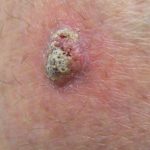 Cancer of the flattened (squamous) epithelium.
Cancer of the flattened (squamous) epithelium.
A common type of cancer which usually develops in the outer layer of the skin, on the lips, or inside the mouth or oesophagus.
The second most common type of skin cancer. The two other common types are basal cell carcinoma and malignant melanoma. Squamous cell carcinoma arises from the epidermis (the outer layer of skin). It is more aggressive than basal cell cancer and more likely to spread to other locations such as nearby lymph nodes. Left untreated, tumors may even spread into internal organs and become incurable, Squamous cell carcinoma is slow growing and, when properly treated, has a very high cure rate (more than 95 percent). The principal risk factor for developing squamous cell cancer is chronic sun exposure. Any new growth that changes color, ulcerates, bleeds, or does not heal can be an indication of squamous cell carcinoma and the person should seek medical attention. Squamous cell carcinoma usually develops from a red, scaly, precancerous skin lesion known as actinic keratosis. Actinic keratoses usually occur on sun-damaged parts of the body, such as the face, scalp, ears, and backs of the hands.
Carcinoma that develops primarily from squamous cells, e.g., of the skin or in the mouth, lungs, bronchi, esophagus, or cervix.
Type of skin cancer more serious than basal cell carcinoma; often characterized by scaly red papules or nodules.
A type of cancer that begins in squamous cells (thin, fiat cells that look like fish scales). Squamous cells are found in the tissue that forms the lining of hollow organs (e.g., vagina, uterus).
Also referred to as SCC, this type of cancer originates in epithelial cells that line the majority of the body’s internal hollow structures as well as its exterior surface. SCC can manifest in various organs, including the lungs and mouth. Skin SCC is one of the most prevalent forms of skin cancer and is associated with prolonged sun exposure. It is most commonly found in individuals with fair skin who are over the age of 60.
Skin SCC typically begins as a small, non-painful bump or patch, often appearing on the lip, ear, or back of the hand. It tends to grow relatively quickly and may look like a wart or ulcer. The cancer can also develop from an existing condition known as solar keratosis, which is characterized by rough or thickened skin patches. If not addressed, the cancer has the potential to metastasize to other areas of the body and become life-threatening.
Diagnosis is confirmed through a skin biopsy. The tumor can either be surgically excised or treated with radiation therapy.
